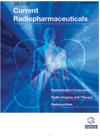- Home
- A-Z Publications
- Current Radiopharmaceuticals
- Previous Issues
- Volume 17, Issue 3, 2024
Current Radiopharmaceuticals - Volume 17, Issue 3, 2024
Volume 17, Issue 3, 2024
-
-
An In-depth Analysis of the Adverse Effects of Ionizing Radiation Exposure on Cardiac Catheterization Staffs
More LessAuthors: Maryam Alvandi, Roozbeh N. Javid, Zahra Shaghaghi, Soghra Farzipour and Sahar NosratiDiagnostic and interventional angiograms are instrumental in the multidisciplinary approach to CAD management, enabling accurate diagnosis and effective targeted treatments that significantly enhance patient care and cardiovascular outcomes. However, cath lab staff, including interventional cardiologists, is consistently exposed to ionizing radiation, which poses inherent health risks. Radiation exposure in the cath lab primarily Read More
-
-
-
Impact of Radiation Therapy on Serum Humanin and MOTS-c Levels in Patients with Lung or Breast Cancer
More LessBackground: Lung and breast cancer are the most frequent causes of death from cancer globally. The objectives of this research were to evaluate the serum mitochondrial open reading frame of the 12S rRNA-c (MOTS-c) and humanin levels in lung or breast cancer patients, and investigate the impacts of radiation therapy on the circulating levels of these peptides. Methods: 35 lung cancer patients, 34 breast cancer patients, an Read More
-
-
-
Radiation-induced Testicular Damage in Mice: Protective Effects of Apigenin Revealed by Histopathological Evaluation
More LessBackground: Radiation exposure poses a significant threat to reproductive health, particularly the male reproductive system. The testes, being highly sensitive to radiation, are susceptible to damage that can impair fertility and overall reproductive function. The study aims to investigate the radioprotective effects of apigenin on the testis through histopathological evaluation. Materials and Methods: This research involved utili Read More
-
-
-
Performance of Iron Phosphate Glass Containing Various Heavy Metal Oxides for Particulate Nuclear Radiation Shielding
More LessAuthors: Bassem Abdelwahab, G.S.M. Ahmed, M. El-Ghazaly, A. Zoulfakar, S.M. Salem, I.I. Bashter and A.G. MostafaBackground: Employees may be exposed to different kinds of ionizing radiation at work. When ionizing radiation interacts with human cells, it can cause damage to the cells and genetic material. Therefore, one of the scientists' primary objectives has always been to create the best radiation-shielding materials. Glass could offer promising shielding material resulting from the high flexibility of composition, simplicity of producti Read More
-
-
-
The Radioprotective Effect of LBP on Neurogenesis and Cognition after Acute Radiation Exposure
More LessAuthors: Gang Yin, Qinqi Wang, Tongtong Lv, Yifan Liu, Xiaochun Peng, Xianqin Zeng and Jiangrong HuangBackground: Radiation exposure has been linked to the development of brain damage and cognitive impairment, but the protective effect and mechanism of Lycium barbarum pills (LBP) on radiation-induced neurological damage remains to be clarified. Methods: Behavioral tests and immunohistochemical studies were conducted to evaluate the protective effects of LBP extract (10 g/kg orally daily for 4 weeks) against Read More
-
-
-
Development and Validation of a Nomogram for Predicting Breast Malignancy in Male Patients Based on Clinical and Ultrasound Features
More LessAuthors: Wei-Hong Dong, Gang Wu, Nan Zhao and Juan ZhangObjective: This study aimed to construct a nomogram based on clinical and ultrasound (US) features to predict breast malignancy in males. Methods: The medical records between August, 2021 and February, 2023 were retrospectively collected from the database. Patients included in this study were randomly divided into training and validation sets in a 7:3 ratio. The models for predicting the risk of malignancy in male pati Read More
-
-
-
Hepatopulmonary Shunt Ratio Verification Model for Transarterial Radioembolization
More LessIntroduction: The most important toxicity of transarterial radioembolization therapy applied in liver malignancies is radiation pneumonitis and fibrosis due to hepatopulmonary shunt of Yttrium-90 (90Y) microspheres. Currently, Technetium-99m macroaggregated albumin (99mTc-MAA) scintigraphic images are used to estimate lung shunt fraction (LSF) before treatment. The aim of this study was to create a phantom to Read More
-
-
-
“One Method to Label Them All”: A Single Fully Automated Protocol for GMP-Compliant 68Ga Radiolabeling of PSMA-11, Transposable to PSMA-I&T and PSMA-617
More LessAuthors: Juliette Fouillet, Charlotte Donzé, Emmanuel Deshayes, Lore Santoro, Léa Rubira and Cyril FersingBackground: Prostate-specific membrane antigen (PSMA) is an ideal target for molecular imaging and targeted radionuclide therapy in prostate cancer. Consequently, various PSMA ligands were developed. Some of these molecules are functionalized with a chelator that can host radiometals, such as 68Ga for PET imaging. The 68Ga radiolabeling step benefits from process automation, making it more robust and reducing radi Read More
-
-
-
Automated Synthesis of [11C]PiB via [11CH3OTf]-as Methylating Agent for PET Imaging of β-Amyloid
More LessAuthors: Akhilesh K. Singh, Sanjay Gambhir and Manish DixitAim: Efficient synthesis of precursor from commercially available starting materials and automated radiosynthesis of [11C]PiB using commercially available dedicated [11C]- Chemistry module from the synthesized precursor. Background: [11C]PiB is a promising radiotracer for PET imaging of β-Amyloid, advancing Alzheimer's disease research. The availability of precursors and protocols for efficient radiolabelling foster the applic Read More
-
Most Read This Month
Article
content/journals/crp
Journal
10
5
false
en


